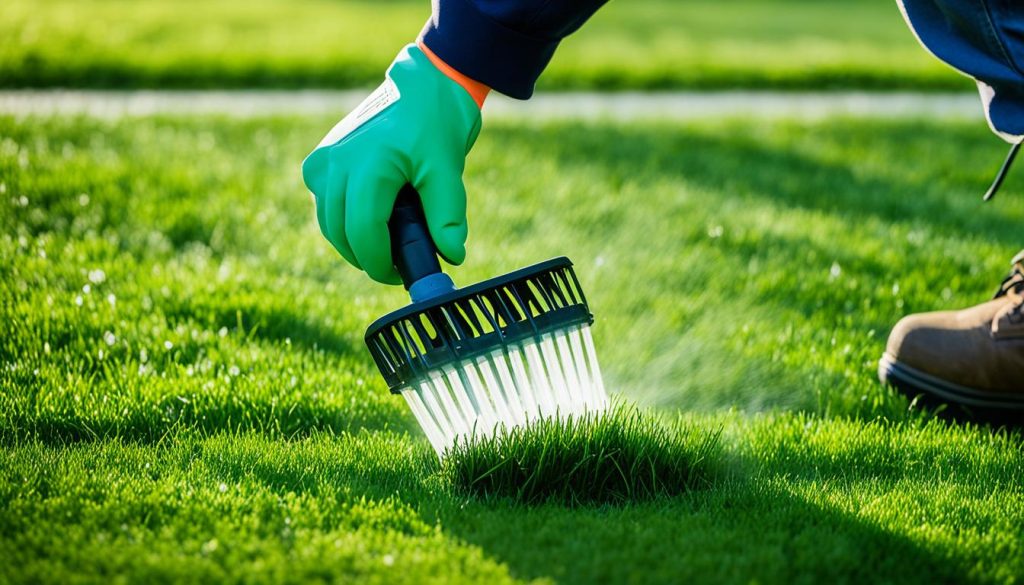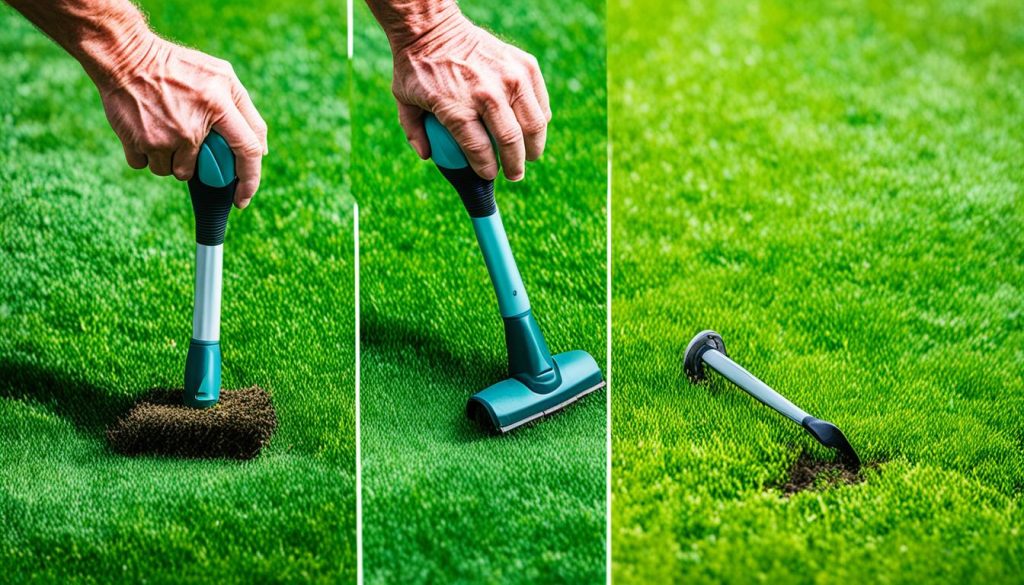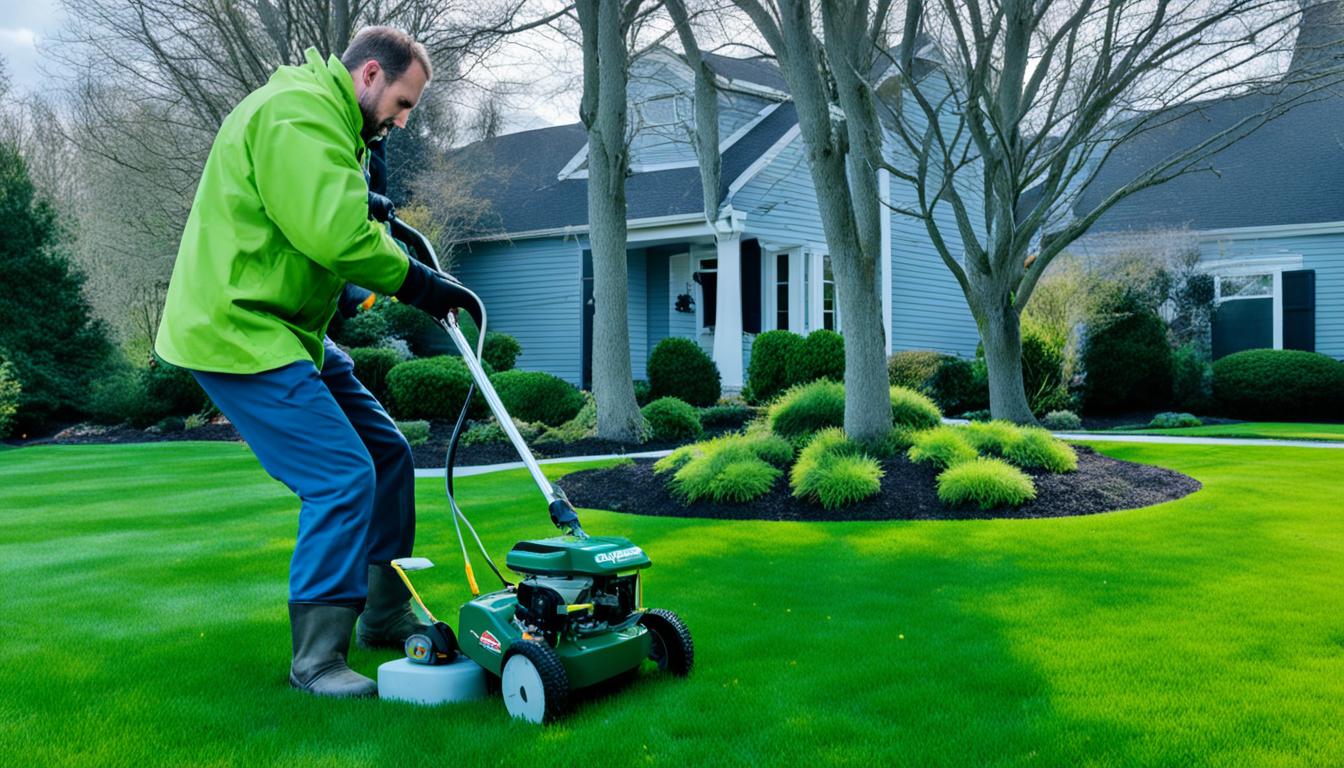Do you believe that aerating your lawn is a cumbersome task that requires expensive machinery and professional expertise? Think again! Contrary to common beliefs, aerating your lawn by hand can be a highly effective and straightforward process, allowing you to improve the health and vitality of your lawn without breaking the bank.
In this article, we will guide you through the process of manual lawn aeration, providing you with valuable insights and tips on how to achieve a lush and thriving lawn all on your own. Discover the simple DIY techniques to aerate your lawn by hand, the best time to do it, and the tools you’ll need to get the job done efficiently.
Key Takeaways:
- Manual lawn aeration is a cost-effective alternative to using heavy machinery.
- Aerating your lawn by hand allows you to have greater control over the process and fosters a stronger connection with your lawn.
- Timing is crucial – aerate warm-season grasses in late spring to early summer and cool-season grasses in late summer or early fall.
- Key tools for manual lawn aeration include a lawn aerator, a lawnmower, a garden hose and sprinkler, and markers to identify obstacles.
- Follow our step-by-step guide and additional tips for effective lawn aeration.
Why Aerate Your Lawn
Lawn aeration is a vital practice for maintaining a healthy and vibrant lawn. By aerating your lawn, you create channels that allow water, oxygen, and nutrients to penetrate the soil and reach the grassroots. This promotes optimal growth and improves the overall appearance of your lawn.
Aeration offers a range of benefits for your lawn:
- Improved Drainage: Aerating your lawn helps prevent water from pooling on the surface, reducing the risk of waterlogged areas and potential damage to your grass.
- Reduced Soil Compaction: Over time, soil can become compacted, limiting root growth and nutrient absorption. Aeration loosens the soil, allowing roots to spread and access vital resources.
- Controlled Thatch Buildup: Thatch refers to the layer of dead grass, roots, and debris that accumulates between the soil and the green grass blades. Aerating your lawn helps break down thatch and aids in its decomposition, preventing an excessive buildup that can suffocate your lawn.
Aeration is a key step in maintaining the health and quality of your lawn. By incorporating regular lawn aeration into your lawn care routine, you can ensure that your grass receives the essential elements it needs to flourish.
When to Aerate Your Lawn
The timing of lawn aeration is crucial to achieve optimal results. The ideal time to aerate your lawn depends on the type of grass you have. Warm-season grasses should be aerated during their active growth period, which typically falls between late spring and early summer. On the other hand, cool-season grasses should be aerated in late summer or early fall. It is essential to consider the specific growth patterns of your grass to determine the most suitable time for aeration.
Aeration is best done when the soil is slightly moist but not overly saturated. This moisture level ensures that the soil is more pliable, making it easier for the aerator to penetrate and extract the cores. Aerating when the soil is too dry can lead to ineffective results, while aerating when it’s too wet can cause soil compaction instead of alleviating it. Monitoring the moisture content of the soil is key to achieving successful lawn aeration.
To determine if your lawn needs aeration, look out for signs such as excessive thatch buildup, poor drainage, or compacted soil. By addressing these issues and aerating at the appropriate time, you can maximize the benefits of lawn aeration and promote a healthier, greener lawn.
| Grass Type | Ideal Aeration Time |
|---|---|
| Warm Season Grasses | Late spring to early summer |
| Cool Season Grasses | Late summer to early fall |

Tools and Materials for Manual Lawn Aeration
Before you begin aerating your lawn by hand, gather the necessary tools and materials. The most important tool is a lawn aerator, which can be a manual spike aerator, a manual core aerator, or a garden fork. You will also need a lawnmower to trim the grass, a garden hose and sprinkler for watering, and markers to identify any obstacles in your lawn.
Manual Spike Aerator
A manual spike aerator is a simple and affordable tool that consists of a long handle with metal spikes at the bottom. To use it, walk across your lawn, pushing the spikes into the ground to create holes. This method helps to break up compacted soil and allows air, water, and nutrients to reach the grassroots.
Manual Core Aerator
A manual core aerator, also known as a hollow tine aerator, removes small plugs or cores of soil from your lawn. This tool creates deeper holes compared to a spike aerator, providing better aeration and soil compaction relief. Manual core aerators typically have a footplate or step for easy penetration into the ground.
Garden Fork
If you don’t have access to specific lawn aerating tools, a garden fork can be a useful alternative. Simply drive the fork tines into the soil at regular intervals, creating openings for air and water. This method is more labor-intensive but can still achieve effective lawn aeration.
Step-by-Step Guide to Aerate Lawn by Hand
Follow these steps to aerate your lawn manually:
- Prepare the lawn by mowing it to a short height and removing any debris.
- Water the lawn thoroughly a day before aeration to ensure the soil is slightly moist, but not overly saturated.
- Check for any underground utilities or sprinkler systems to avoid damaging them during aeration.
- Choose the right manual aerator for your lawn, such as a spike aerator, core aerator, or garden fork.
- Starting from one corner of the lawn, insert the aerator into the ground, pushing it down to the desired depth and then pull it back up.
- Continue this process, spacing the holes evenly across the entire lawn. Aim for a hole spacing of 2-6 inches, depending on the soil type and grass variety.
- If using a manual core aerator, remove the soil plugs from the holes and scatter them across the lawn.
- Repeat the aeration process in multiple directions to improve coverage.
- Once the entire lawn is aerated, water the area again to help the soil settle and promote better grass growth.
- Consider topdressing the lawn with compost or sand to enhance soil health.
Following these steps will ensure proper manual lawn aeration, allowing your lawn to reap the benefits of improved airflow, nutrient absorption, and enhanced root development.
Pros and Cons of Aerating Your Lawn by Hand
Aerating your lawn by hand offers both advantages and disadvantages. Understanding these pros and cons can help you make an informed decision about whether manual lawn aeration is the right method for you.
Pros of Aerating Lawn by Hand
1. Greater Control: When aerating your lawn by hand, you have the advantage of having complete control over the process. You can easily target specific areas that require more aeration, ensuring that the soil receives the necessary oxygen and nutrients.
2. Stronger Connection with Your Lawn: Manual lawn aeration allows you to physically engage with your lawn, fostering a deeper connection and appreciation for its health and well-being. It can be a rewarding experience for those who enjoy hands-on tasks and take pride in caring for their lawn.
3. Budget-Friendly: One of the major benefits of aerating your lawn by hand is cost-effectiveness. Manual aerating tools are typically more affordable than mechanized aerators and require no additional expenses for fuel or maintenance.
Cons of Aerating Lawn by Hand
1. Time-Consuming: Hand aeration can be time-consuming, especially for larger lawns. Unlike mechanized aerators that cover a wider area in less time, manual aeration requires more effort and patience. It may not be the ideal choice for those with limited time or physical abilities.
2. Physically Demanding: Aerating a lawn by hand can be physically demanding, especially if the soil is compacted or the grass is thick. The repetitive task of inserting the aerator into the ground and extracting soil plugs can be strenuous for some individuals. It’s important to assess your physical capabilities before opting for manual lawn aeration.
To summarize, aerating your lawn by hand offers control, a closer connection with your lawn, and affordability. However, it can be time-consuming and physically demanding. Consider these pros and cons when deciding on the aeration method that suits your needs.

| Pros of Hand Aerating | Cons of Hand Aerating |
|---|---|
| Greater control over the process | Time-consuming |
| Fosters a stronger connection with your lawn | Physically demanding |
| Cost-effective |
Additional Tips for Effective Lawn Aeration
1. Choose the Right Time
Timing is crucial when it comes to manual lawn aeration. The best time to aerate your lawn is during its active growth phase. For warm-season grasses, this is typically in late spring or early summer, while cool-season grasses should be aerated in late summer or early fall. By aerating at the right time, you ensure that your lawn can recover quickly and benefit from the aeration process.
2. Water Your Lawn
Prior to aeration, it’s important to properly water your lawn. A day or two before aerating, give your lawn a deep watering to ensure that the soil is moist but not excessively saturated. This will make it easier for the aerator to penetrate the soil and create the necessary channels for air, water, and nutrients to reach the grassroots.
3. Aerate in Multiple Directions
When aerating your lawn by hand, it’s beneficial to aerate in multiple directions. This helps to ensure that the entire area is properly aerated and reduces the risk of missing any spots. By creating a crisscross pattern or alternating the direction of your aeration lines, you can achieve more thorough coverage and promote better lawn health.
4. Overlap Aeration Holes
While manually aerating your lawn, it’s important to overlap the aeration holes. This means that each subsequent hole should partially overlap the previous one. By doing this, you maximize the coverage and create a more interconnected network of channels throughout your lawn. This allows for better water penetration, nutrient absorption, and gas exchange within the soil.
5. Overseed and Fertilize
If your lawn has bare patches or thin areas, consider overseeding after aeration. The aeration process creates the perfect environment for seed germination and allows the new grass to establish strong roots. Additionally, it’s a good idea to fertilize your lawn after aeration to provide it with the necessary nutrients for healthy growth. Be sure to choose a slow-release fertilizer to avoid overwhelming your lawn with excessive nutrients.
6. Follow Up with Maintenance
After aerating your lawn, it’s essential to follow up with proper maintenance. Regularly water your lawn to keep the soil moist, but avoid overwatering. Maintain a consistent mowing height and remove any thatch buildup. By implementing a comprehensive maintenance routine, you can maximize the benefits of lawn aeration and keep your lawn looking its best.
By following these additional tips for effective lawn aeration, you can ensure that your manual aeration efforts yield optimal results. Remember to aerate at the right time, water your lawn appropriately, and follow up with proper maintenance for a lush and healthy lawn.
Troubleshooting Common Aeration Problems
While aerating your lawn by hand, you may encounter some common problems that can affect the effectiveness of the aeration process. Understanding and addressing these issues will help ensure successful lawn aeration and promote a healthier, more vibrant lawn.
Shallow Core Depth
One common problem during manual lawn aeration is achieving shallow core depth. This can occur when using a manual spike aerator or garden fork and can limit the benefits of aeration. To overcome this problem, consider using a manual core aerator instead, as it creates deeper and more effective holes in the soil. By using a core aerator, you can ensure that the aeration process reaches deep into the lawn and provides maximum benefits.
Uneven Aeration
Uneven aeration can lead to inconsistent results and may even create patchy areas in your lawn. This can be caused by factors such as insufficient overlap between aeration passes or varying levels of soil compaction. To address this issue, make sure to create overlapping aeration passes, ensuring that each area of the lawn receives equal attention. Additionally, pay close attention to soil compaction in areas with heavy foot traffic or where machinery has caused compression. By aerating these areas more thoroughly, you can achieve more even and consistent aeration across your entire lawn.
Compacted Soil Resistance
Compacted soil resistance can impede the penetration of aerator tines into the soil, making it difficult to aerate effectively. This can occur in clay or heavily compacted soils. To overcome this problem, ensure that the soil is properly moistened before aerating. Watering the lawn a day or two before aeration will help soften the soil and reduce resistance, making it easier to penetrate with the aerator tines. Additionally, consider using a core aerator, as it is more effective at breaking up compacted soil and facilitating better aeration.
If you are facing persistent problems with your lawn’s aeration, despite taking the necessary steps and precautions, it may be advisable to consult a lawn care professional. They can provide expert guidance and help address any specific issues that may be hindering the aeration process.
| Common Aeration Problems | Solutions |
|---|---|
| Shallow core depth | Use a manual core aerator for deeper holes |
| Uneven aeration | Create overlapping aeration passes and focus on heavily compacted areas |
| Compacted soil resistance | Ensure proper soil moisture and consider using a core aerator |
Conclusion
Manual lawn aeration provides a cost-effective and efficient method for maintaining a healthy and vibrant lawn. By following the step-by-step guide and using the right tools, you can ensure that your lawn receives the essential oxygen, water, and nutrients it needs to thrive. It is crucial to aerate your lawn at the appropriate time, taking into consideration the grass type and soil conditions.
With proper care and attention, your lawn will reward you with lush and vibrant growth. Manual aeration allows you to have greater control over the process and fosters a stronger connection with your lawn. Furthermore, it is a budget-friendly alternative to mechanical aerators.
However, it’s important to note that manual lawn aeration can be time-consuming and physically demanding, especially for larger lawns. Before opting for manual aeration, consider your available time and physical capabilities. If you have a larger lawn or require a more efficient solution, consulting a lawn care professional may be advisable.
In conclusion, manual lawn aeration offers a practical and effective way to promote the health and vitality of your lawn. By following the outlined steps, considering the pros and cons, and implementing additional tips, you can achieve a thriving and beautiful lawn.





